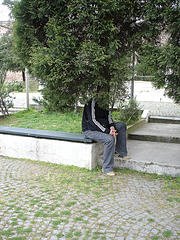We live in a panoptical environment, surrounded by and embedded in its mediatized matrix. Media facilitate the new-found land we stand on. Meditated representation has replaced the represented. It is the truth. Not as a metaphor, not as a warning, but more real then the soil we grow our crops on. Complex unknowable matter and emotion is replaced by easily mediated sound bytes and video clips. It has become our primary source for knowing. Personal representations are overtly available. You can find photos of my family, you can see where I live, you know what I like and dislike, you know what work I do and when I’m on the move. And I know about you.
Democratic models for designing media turn everyone into an accomplice. The dialectical model of the watcher and the watched is outdated. Everybody is watching everybody. Power relations and its inherent oppression have also been democratized. It is also no longer valid to presume that conformity becomes the normal behaviour for individuals who wish to remain unnoticed, nor that the culpability of oppression shifts from the watcher to the watched. Everybody’s been given shared responsibility for the design that facilitates our gaze. We’re all guilty.This mutually inclusive panoptical village creates panoptical behaviour. Since representation replaced the represented media-attention is what we desire. We need to be seen on-screen. We need to be universally visible, findable and understandable and to accommodate this need, we need to be simplified. The immense popularity of reality TV, talent shows, cosplay, live action role playing, online communities, and other forms of direct mediation of the individual is a direct consequence of the fact that to be part of life we need to be part of the mediated world. Life is there.
We discarded our desire to be unseen, and yet a strategy of camouflage lies at the very heart of all this; just not in a traditional twigs-and-leaves kind of way. Camouflage is a method of concealing yourself from an enemy by making yourself appear to be part of the natural surroundings. The difference now is that our natural surroundings, the surroundings in which we are born, are a landscape of meditated representations, and in the participatory democratic model we are our own enemy. We show ourselves so that we remain unseen. We are in a state of post-camouflaged invisibility: the visual void in total presence. In the slipstream of total visuality arrives its inevitable consequence: the more we see, the more we are not seeing. Reading the visual becomes almost an impossibility in a world where one image-cloud is replaced by the next image-cloud ever quicker. The overwhelmed eye is an indifferent eye. The art of being unseen and thus undefinable has transformed into the art of being definable in infinite variations. Information is evolving as we watch, and thus it is in a constant state of incompletion. It is not an accumulation of facts but of alterations, re-calculations and re-interpretations. It never is.
In this situation what we cannot see becomes what we are most obsessed with. And as in any good horror movie, what we don’t see drives our imagination and actions. It is the paradox of this time that with all that we know our actions are still driven by that which we don’t. The camouflaged skin is the perfect projection screen for what we fear, love and believe. Believing is seeing.
As this negative space enters the fantasy of democratized power, it starts to shape events. It is a game of coding and decoding. How serious it gets, depends on where the game is being played and what’s at stake. The artists in this exhibition try to find the glitch in the omnipresent matrix by scripting their own unknowable environment. Interpreting what is not known is the greatest challenge of any surveillance-specialist. We project a reality on top of things. The artist is a shaman/hacker voluntarily stuck in a wormhole between positive and negative space, between the represented, and the representation. By suggestion, omitting and abstracting the artist makes the absence felt. Perhaps because he instinctively want us to remember that once we were godlike beings that deserved more then a TV dinner.
Thursday, February 19, 2009
Subscribe to:
Posts (Atom)
